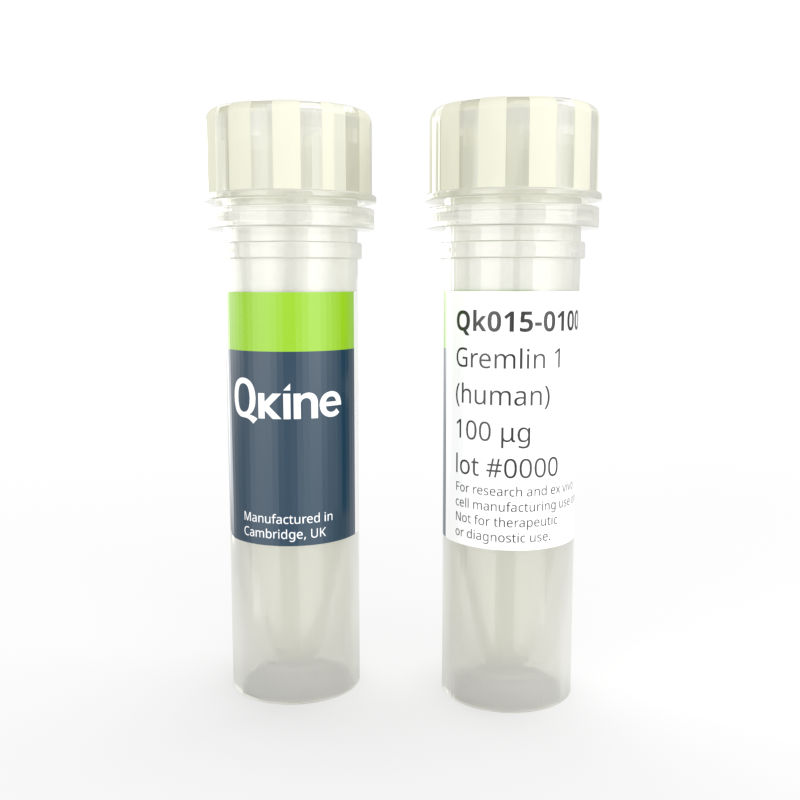Recombinant human gremlin 1 protein
QK015
Brand: Qkine
Human gremlin 1 protein is a BMP-inhibitor present in the natural intestinal niche and provides an alternative to noggin for optimization of intestinal organoid culture and iPSC differentiation.
Qkine gremlin 1 has been optimized by our experts to be an exceptionally high-purity 18 kDa highly bioactive dimeric protein, animal origin-free (AOF) and carrier protein free.

Currency:
| Product name | Catalog number | Pack size | Price | Price (USD) | Price (GBP) | Price (EUR) |
|---|---|---|---|---|---|---|
| Recombinant human/bovine/porcine gremlin 1 protein, 50 µg | QK015-0050 | 50 µg | (select above) | $ 185.00 | £ 140.00 | € 164.00 |
| Recombinant human/bovine/porcine gremlin 1 protein, 100 µg | QK015-0100 | 100 µg | (select above) | $ 280.00 | £ 210.00 | € 246.00 |
| Recombinant human/bovine/porcine gremlin 1 protein, 500 µg | QK015-0500 | 500 µg | (select above) | $ 725.00 | £ 540.00 | € 631.00 |
| Recombinant human/bovine/porcine gremlin 1 protein, 1000 µg | QK015-1000 | 1000 µg | (select above) | $ 1,050.00 | £ 800.00 | € 935.00 |
Note: prices shown do not include shipping and handling charges.
Qkine company name and logo are the property of Qkine Ltd. UK.
Alternative protein names
Species reactivity
Human, bovine, porcine
Species similarity:
mouse – 99%
rat – 99%
Summary
- High purity human gremlin 1 protein (Uniprot: O60565)
- 18 kDa
- >98%, by SDS-PAGE quantitative densitometry
- Expressed in E. coli
- Animal origin-free (AOF) and carrier protein-free
- Manufactured in Qkine's Cambridge, UK laboratories
- Lyophilized from acetonitrile, TFA
- Resuspend in 10 mM HCl (Reconstitution solution A) at >50 µg/ml, add carrier protein if desired, prepare single-use aliquots and store frozen at -20 °C (short-term) or -80 °C (long-term)
Featured applications
- Tumor organoid culture
Bioactivity
Gremlin-1 inhibits BMP-2 induced luciferase activity BRE-HEK293 luciferase reporter assay with an IC50 = 34 ng/ml (1.88 nM). Gremlin 1 activity is determined using inhibition of the BMP-2 response (Qk007 #010, 52 ng/ml) from a BMP2-responsive firefly luciferase reporter in stably transfected HEK293T cells. Cells are treated (n=4) with a serial dilution of gremlin 1 in BMP-2 for 6 hours. Firefly luciferase activity is measured and normalized to the control Renilla luciferase activity. Data from Qk015 batch #011.

Purity
Gremlin 1 protein migrates as a single diffuse band at ~36 kDa in non-reducing (NR) and 19 kDa in reducing (R) conditions. The protein is a non-covalent dimer and it is the dissociation of the dimer during electrophoresis which gives the characteristic diffuse band. Purified recombinant protein (7 µg) was resolved using 15% w/v SDS-PAGE in reduced (+β-mercaptothanol, R) and non-reduced conditions (NR) and stained with Coomassie Brilliant Blue R250. Data from Qk015 lot #011.

Further quality assays
- Mass spectrometry: single species with expected mass
- Analytical reversed-phase: single sharp peak
- Endotoxin: <0.005 EU/μg protein (below level of detection)
- Recovery from stock vial: >95%
Protein background
Gremlin 1 protein (GREM1, isoform-1) belongs to the bone morphogenetic protein (BMP) antagonist family. Gremlin 1 protein binds BMP-2, BMP-4, BMP-7 and other BMP family proteins [1] and inhibits receptor binding. It is highly expressed in the small intestine at the base of the intestinal crypts, as are the related proteins, gremlin 2 and chordin-like 1. In this niche, they help maintain the stem cell population by inhibiting BMP produced by mesenchymal cells [2]. Expression of gremlin 1 protein is also detected in fetal brain and colon, and at lower levels in adult brain, prostate, pancreas and skeletal muscle.
Recombinant human gremlin 1 protein and other BMP-antagonists, such as noggin, are used in the derivation, growth and maintenance of organoids from epithelial tissues including intestinal, liver and pancreatic organoids. However, roles for recombinant gremlin 1 protein in cancer stem cell maintenance in glioblastoma have been suggested [3].
Background references
- Kišonaitė, M., Wang, X. & Hyvönen, M. Structure of Gremlin-1 and analysis of its interaction with BMP-2. The Biochemical journal 473, 1593–1604 (2016). doi.org/10.1042/BCJ20160254
- Kosinski, C. et al. Gene expression patterns of human colon tops and basal crypts and BMP antagonists as intestinal stem cell niche factors. Proceedings of the National Academy of Sciences of the United States of America 104, 15418–15423 (2007). doi.org/10.1073/pnas.0707210104
- Yan, K. et al. Glioma cancer stem cells secrete Gremlin1 to promote their maintenance within the tumor hierarchy. Genes & development 28, 1085–1100 (2014). doi: 10.1101/gad.235515.113
Publications using Recombinant human gremlin 1 protein (Qk015)
Basal delamination during mouse gastrulation primes pluripotent cells for differentiationSato N, Rosa VS, Makhlouf A et al.
DOI: doi: 10.1016/j.devcel.2024.03.008